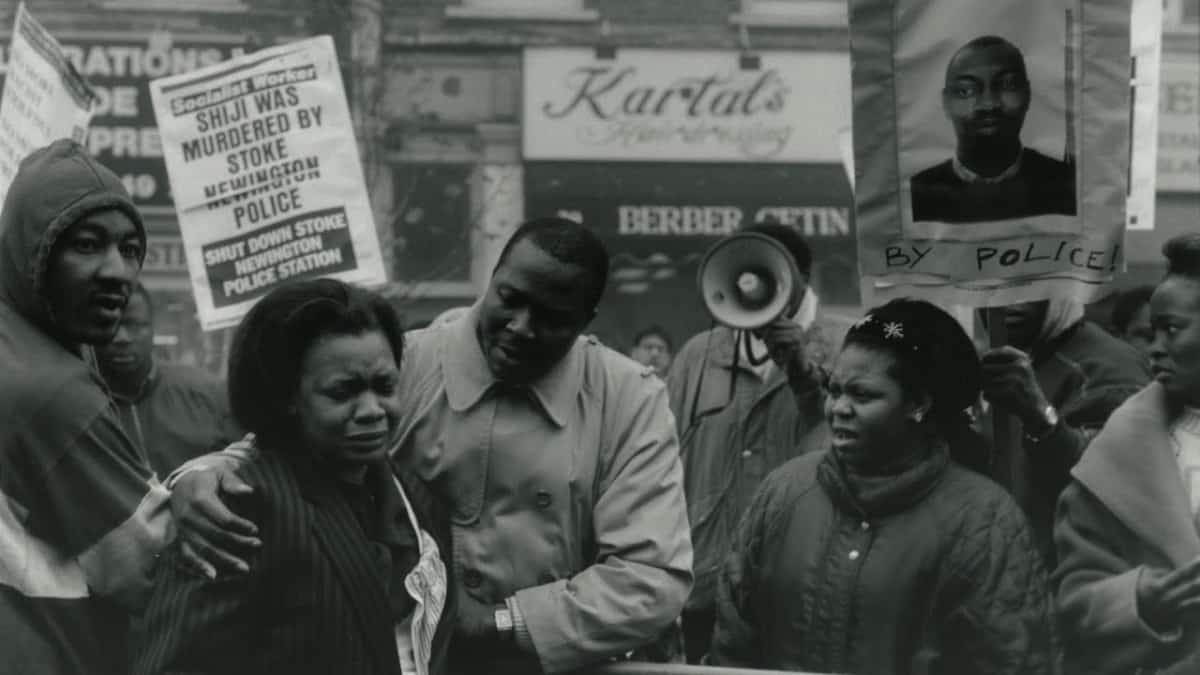Back in June, as Black Lives Matter protests started once again in the wake of the murder of George Floyd, a phrase kept cropping up on placards and social media feeds across Britain: “The UK is not innocent”. For clear evidence of that you need only look to Ken Fero and Tariq Mehmood’s 2001 documentary Injustice, about the deaths in British police custody of countless individuals, almost entirely Black men. With a renewed pressure on institutions to tackle structural racism and with calls to defund the police tentatively entering mainstream political discourse, now would seem the perfect time for the release of Fero and Mehmood’s follow-up film Ultraviolence, which once again places race and class at the centre of a distressing study of police brutality.

A title card towards the beginning of the film informs us that there have been more than 2000 deaths in police custody in the last 50 years. The film focuses in on six cases: Christopher Adler, Brian Douglas, Jean Charles de Menezes, Paul Coker, Roger Sylvester and Nuur Saeed. Mixing interview footage with animated sequences, the documentary recounts the events of their deaths and charts the attempts of their families to seek justice. It is framed as a letter from Fero to his son: as “a memory for those that cannot forget, and a warning for those that refuse to see.”
The term “ultraviolence” – or “ultra-violence”, as it was popularised in Anthony Burgess’ novel A Clockwork Orange – is usually now reserved for describing the kind of maximalist, aestheticised carnage you’d expect from, say, a Tarantino flick. Fero and Mehmood’s documentary lives up to its title, but the most shocking footage here is the entirely unsensationalised CCTV videotapes of the deaths of Christopher Adler and Paul Coker. The ultraviolence is not only injuries they sustained at the hands of the police, but also the violence of those officers who stood by, chatted – laughed, even – and did nothing.

As the film launches into full attack on the police, the Independent Police Complaints Commission (IPCC) and the British government, power and the duties of the media emerge as key themes. Fero’s own role as narrator-director doesn’t escape scrutiny. “Does the evidence of violence on film make any difference?” Fero anxiously asks, citing the famous documentation of the aftermath of napalm attacks broadcast during the Vietnam War. In fact, much of the film is concerned with connecting the violence of war – particularly the Iraq War – to violence back in the UK. There’s certainly lots to be said about that grim reflection, but the film is often less than eloquent on the subject, which ultimately just ends up diluting the more compelling material.
A bigger problem is the film’s insistence on using abrasive, Godardian text-over-image at every opportunity. Perhaps that was once an effective tool for disrupting our viewing experience, but here it comes across as an affected, backward-looking arthouse trope, done poorly; flashing the words “FETISHIST DISAVOWEL” over the IPCC’s excuse-ridden report on the death of Christopher Adler, for example, does nothing more to enlighten the viewer. What Ultraviolence lacks – and this is what prevents it from transforming essential material into a truly great film – is the aesthetic imagination to transmit its political protest to a contemporary audience by way of original cinematic means.

Stylistic missteps don’t, however, completely detract from what remains an often powerful documentary. As it is, the film is better when Fero has faith in his raw footage – not just the horrendous filming of police brutality and neglect, but also that of the victim’s families protesting injustice on the streets and in various meetings. Ultraviolence is an incredibly bleak film designed to provoke anger, and in that sense it proves highly effective.
Ultraviolence‘s release date is yet to be announced.
